
Fluxes/Diarrhea and Related Illnesses Page Menu: 1 2 3 4 5 6 7 8 9 10 11 Next>>
Treating Fluxes in the Golden Age of Piracy, Page 2
Types of Fluxes - Lientery and Cæliac Affection
The Lientery and Cæliac Affection are two types of diarrhea which are similar in nature and not widely discussed in the sea surgeon's manuals. Naval physician William Cockburn gives these extensive coverage, however.

Sea-Surgeon & Author John Woodall
Image from the surgions mate
(1617)
Of the two illness, the lientery is mentioned by sea-surgeon John Woodall, who defined it as a "Fluxe which either passeth the sustenance taken, wholy undigested, and that without any bloud at all, and without great paine, or as it were halfe digested."1 Cockburn crafts a more precise definition, noting that when "Food passes out of the Stomach without any Degree of Concoction, Hippocrates calls the Disease a Lientery."2 This definition specifies a Lientery as resulting only in undigested food being found in the stool, a distinction Woodall does not make. Instead, Woodall unceremoniously lumps both partially digested and undigested food in the stool as being symptoms of a Lientery.
Cockburn notes that if food "has undergone any Degrees of Concoction, the Disease then is known by the Cæliack, or Stomach Affection"4 [Emphasis mine]. He gives even more detail about this Affection explaining that it occurs when "the Food has remained long enough in the Stomach to be concocted, but the Chyle, or Cream of the Food, is afterwards carry'd off liquid, and not perfectly digested"5. Cockburn continues his explanation of this illness noting that "the Chyle goes through the Sick, and passes off in their Stools; [so] the Defect which occasions the Cæliack Affection must be found in the Guts; and not in the Stomach; which has finished its Work, when the Food has been turned into Chyle."6 In Cockburn's book, the salient difference between the Lientery and the Cæliack Affection is the presence of partially digested food, or chyle.

Photo: US Gov't
A Sample of Chyle
Chyle is sort of a fascinating concept and bears closer examination. It is a milky fluid consisting of lymph and emulsified fats which is actually formed in the intestines during digestion. According to the period theory, the stomach 'concocts' the chyle which flows into the intestines where it can be absorbed and used to support the blood. Cockburn explains that "if we follow the Chyle, especially in the Small Guts, we find it is continually receiving an additional Supply of Liquor [liquid] to render it more fluid; and for that Reason, [the good part of the chyle is] more apt to be driven into the Orifices of the Milky-Vessels, the first stage it makes towards the Blood."7 Meanwhile, "the part of the Chyle that is gross... is driven along the Cavity of the guts till it is entirely thrown out of the body by the Anus"8.
With this in mind, we can examine Cockburn's interesting theory about the cause of the Cæliack Affection. "[I]f we suppose that the Chyle has acquired any Degree of Sharpness, [it] ...will stimulate the Guts, and occasion a quicker Discharge of the Chyle; on both which Accounts of its Thickness and Sharpness, the Chyle, unmixed with other Liquors [liquids] of the Guts, is driven out frequently, and in its own Colour; or, there is a Cæliack Affection."9 In sum, Cockburn is saying that because the chyle is sharp (or perhaps 'harsh' would be a better description), it cannot mix well with the liquids in the intestines and be used to rejuvenate the blood, so it just passes out of the body in the stool.
Cockburn also provides a list of symptoms that he says accompany both the Lientery and Cæliack Affection. The ill is "attended with Faintness, Paleness, a Tympanites [accumulation of excess gas in the intestines] and the Jaundice. ... There is a great Heat in the Hypochondres [the upper lateral
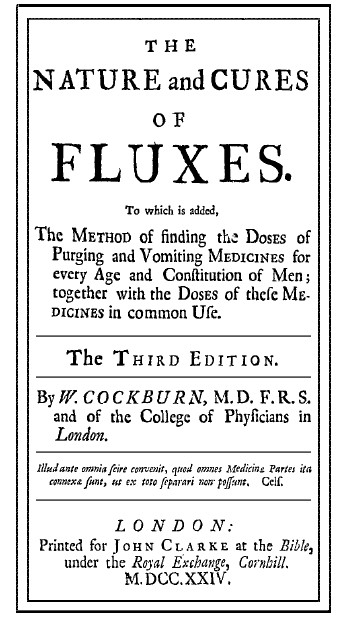
region of the abdomen marked by the lower ribs], and a great Decay of Flesh."10 He later adds
that "the Loosness of a Lientery and Cæliack Affection proceeds and subsists, Physicians have observed their Sick to complain of a very great Heat in the Region of the Hypochondres, a Symptom that is not taken
notice of either in the Diarrhœa, or even in People ill of a Dysentery."11
Most of these problems are chalked up to the lack of support for the blood. Faintness occurs because "the Quantity and Fluidity of the Blood being less than natural, the Blood-Vessels are not sufficiently filled" resulting in the patient being faint and pale.12
The Tympanites seems to puzzle Cockburn, who explains "there does not appear to be any Relation between the Diseases and their Symptom."13 He goes on to suggest that perhaps because the chyle doesn't mix properly in the intestines, they cannot be coated with the (apparently) resulting mucus. According to his theory, the intestines become inflamed and 'stimulated by every sharp Liquor, or other sharp Substance, that passes along in them."14 Through a complex series of events we won't go into, air gets trapped in the greater intestine and "the Abdomen is so stretched and distended, that it does not yield to any Compression, nor receive any Impression, and gives a Sound somewhat resembling the Sound of a Drum ...and giving this Kind of Sound, the Disease plainly takes it Name."15 He suggests that jaundice is "a very desperate symptom [of] the Tympany [swelling of the abdomen with gas] ."16
Cockburn notes that the excessive heat experienced at the stomach is generally not present in a Diarrhea or a Dysentery. His rather vague explanation for this is that the normal fluids which combine with chyle to make it useful to the blood aren't secreted and this somehow produces heat.17 He doesn't seem to be exactly sure how this happens, so he glosses over that point.
The last symptom - loss of flesh, or loss of weight as we would refer to it - occurs because "because the Food (the Recruiter
[or replenisher] of Blood) is carryed out of the Body in a Lientery and Cæliack Affection,
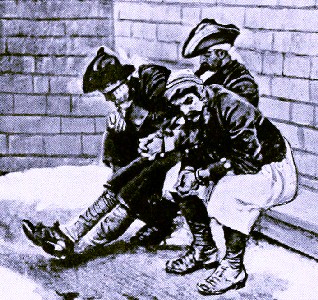
Artist: Howard Pyle
Taken from The Pirate's Christmas (1893)
so must the Decay of Flesh be. And therefore in a Lientery and
Cæliack Affection there is a great Loss and Decay of Flesh."18
Cockburn talks a great deal about the Lientery and how it can be distinguished from a regular diarrhea. He explains that the diarrhea is "the same Night and Day; after a Meal, or if the sick Person fasts... [where the Lientery] only follows eating or drinking"19. With regard to the Lientery, he also notes that "[t]he sooner any Meal is thrown off after it is taken down, and the less Change there is made [to] ...the Food", the more dangerous the Lientery is. On the other hand, the greater the Concoction of the Food, the more it approaches to the Case of a Diarrhœa, [and] the more easily it may be cured."20
Although he devotes a large part of his book to the Lientery and Cæliack Affection, he admits that they both "are very rare Diseases (as they truly are)"21.
1 John Woodall, the surgions mate, p. 202; 2 William Cockburn, The Nature and Cure of Fluxes, p. 169; A. Cornelius Celsus, Of medicine in eight books, see for example p. 49; 4 Cockburn, ibid; 5 Cockburn, p. 6; 6 Cockburn, p. 177-8; 7 Cockburn, p. 19; 8 Cockburn, p. 186; 9 Cockburn, p. 178; 10 Cockburn, p. 184; 11 Cockburn, p. 185; 12 Cockburn, p. 187; 13 Cockburn, p. 188-9; 14 Cockburn, p. 190; 15 Cockburn, p. 189; 16 Cockburn, p. 192; 17 Cockburn, p. 185-6; 18 Cockburn, p. 186-7; 19 Cockburn, p. 203; 20 Cockburn, p. 219; 21 Cockburn, p. 210
Types of Fluxes - The Bloody Flux/Dysentery

A Crowded Ship Could Quickly Succumb to Dysentery
From Nouveau Voyage aux Isles de l'Amerique, V1, p. 45
by Jean-Baptiste Labat (1722)
"In the meantime dysentery started among our men at St. Vincent and compelled M. de Buc to re-embark his troops and come back." (Père Jean-Baptiste Labat, The Memoirs of Père Labat 1693-1705, translated and edited by John Eaden, p. 139)
Dysentery was a matter of great concern for men in close communities such as soldiers and sailors. It was recognized that once it began, a bloody flux might quickly spread through a company of man and take many of them to their graves. Père Labat's example reveals just how concerned some military leaders became when dysentery was in the offing. This would have been as true for pirates as it would for a naval vessel since pirates often packed their ships as full as they could comfortably.
The most succinct period definition of a dysentery can be gathered from various comments made by naval physician William Cockburn. He explains, "It is a Flux, with Griping [sharp pain in the bowels] and Pain over all the Belly, wherein is voided Blood mixed with liquid Excrements; and with them are sometimes a mucous or slimy Substance, and sometimes a Substance more fleshy."1 He specifically details "[t]he proper and distinguishing Symptoms of a Dysentery, are the Exulceration [creation of ulcers] mentioned by every Physician, and the Blood with liquid Excrements; which Blood must likewise be mixed with those Excrements."2 According to him, this is 'most terrible' type of flux because "the Blood, the Fountain and River of Life, is often voided in a very great Abundance"3.
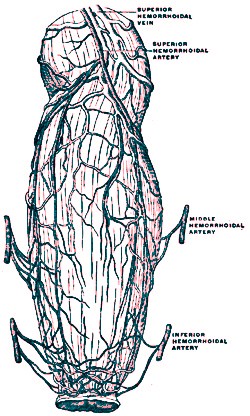
The Hemorrhoidal Veins and Arteries
Image from Gray's Anatomy
(1917)
This mixture of blood with excrements is key to a dysentery according to Cockburn. The revered physician Thomas Sydenham claimed that "sometimes there is no Blood at all mixed with them [the excrements] thro' the whole course of the Disease; yet notwithstanding, if the Stools are frequent with Gripes, and mucous Filth, the Disease may as properly be call'd a Dysentery, as if Blood flow'd out with them."4 Cockburn wants none of this, saying some rather unflattering things about Sydenham5. Curiously, I have found that this sort of behavior is pretty common in period physician's books, sometimes making them sound like a bunch of dour, catty old men.
Cockburn goes on to give very specific detail on how he feels the blood should be properly found in the patient's excrement, explaining that "Blood coming from any Person at Stool, which is not mixed with the Excrements, is not a Dysentery, but ...is from the Hemorrhoidal Vessels, and is the Hemorrhoids or Piles. This Blood is always to be seen, sometimes under the Excrements, and then the Blood precedes it; but most commonly the Blood falls of one side, or lies a top, of the Excrement"6.
The blood flux or dysentery sometimes "begins with Shaking and Shivering, and a heat of the whole Body follows, as is usual in Fevers, and soon after the Gripes and Stools; but oftentimes there is no appearance of a Fever going before... but there are always great tortures, and Depression of the Bowels, and Pain when the Sick goes to stool: the Stools are likewise frequent, with a very troublesome descent, as it were, of the Guts; and they are all mucuous, not excrementitious, excepting that sometimes an excretmentitious Stool comes between, and that is without any great pain."7
John Woodall gives a rather diffuse description of the symptoms of a dysentery, here quoting 'Petrus Bayerius' (Pietro Bairo - author of Segreti Medicinali di Pietro Bairo da Turino)
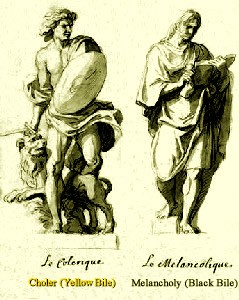
Artist: Charles le Brun
The Humors Choler and Melancholy
From "The 4 Humors of Man" (1674)
. Woodall tells us that Bayro describes it as having a "variety of substances are sent out with the excrement, producing excoriation [abrasion] with dolor [anguish] and paine, as [if] it somewhat were shaven from the small guts, and that shaving, saith he, procedeth from choler [yellow bile - one of the four humors] and turneth to ulceration of the guts, and is compleat in two weekes, or proceedeth of a glassie coloured substance, and hath his termination in foure weekes: or proceedeth of a Melancholy humour [black bile - another of the four humors], and is in perfection [completed] in forty daies: first beginneth the fluxe, then followeth the excoriation, &c."8
Sea surgeon Thomas Aubrey weighs in on the products of a dysentery in a most descriptive fashion. He says during a dysentery "the Patient voids nothing but a purulent Jelly in vast Quantities, which in a few Days is mixt with or succeeded by Blood, flowing out of the mesenterick Veins and Arteries, either by Transcolation [like passing through a sieve], or from a Relaxation of their Orifices. This Blood is not bright and florid, but dark, grumous [lumpy or clotted], and sometimes livid [discolored] till about the seventh Day, and then it is pure red Blood"9. If those three descriptions don't put you off your feed for a while, I don't know what will.
Cockburn gives us another symptom of the bloody flux - weight loss. He actually admits that
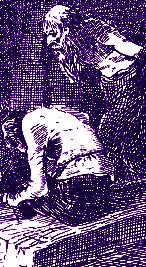
From Captain William Kidd
and Others of the Pirates or
Buccaneers by John S. C.
Abbot, p. 270 (1834)
'that Symptom is produced in both' a dysentery and a diarrhea. (He also explains it is found in Lienteries and Cæliack Affections as you'll recall from the previous section.) Cockburn makes a finer distinction of this symptom in a dysentery, however.
Yet in a Dysentery, the Sick lose their Flesh on another account; for not only the Supplies that recruit the natural Evacuations are carried off, before they reach the Blood, and great and preternatural Secretions are made out of it, at the same time it is deprived of the mentioned Supplies, which is the Cafe in a Diarrhœa; but Blood it self is discharged into the Guts, and voided with liquid Excrements in a Dysentery. And therefore the Vessels of the Body, more particularly the Blood-vessels of the Muscles, being drained of Blood, they are thinner and not so plump, h. e. the Sick of a Dysentery grow lean, and lose their Flesh.10
This is basically the same thing he explained with regard to the Lientery and Cæliack Affection, although he seems to be suggesting that it should happen more quickly in the case of the dysentery.
1 William Cockburn, The Nature and Cure of Fluxes, p. 255; 2 Cockburn, p. 245; 3 Cockburn, p. 6; 4 Thomas Sydenham, The Whole Works of that Excellent Practical Physician Dr. Thomas Sydenham, 10th Edition, p. 117; 5 See for example, Cockburn, Preface, p. xix-xx; 6 Cockburn, p. 256; 7 Sydenham, ibid.; 8 John Woodall, the surgions mate, p. 206; 9 Thomas Aubrey, The Sea-Surgeon or the Guinea Man’s Vadé Mecum., p. 76; 10 Cockburn, p. 265-6
Types of Fluxes - The Bloody Flux/Dysentery - Death
"The Weather was extream hot during our Stay [in Batavia]. Many Men and Officers fell sick, and I was one of the Number. The Master of the Duke, the Gunner of the Dutchess and several of our Men, dy'd of the Flux." (Edward Cooke, A Voyage to the South Sea and Round the World in the Years 1708 to 1711, p. 55)
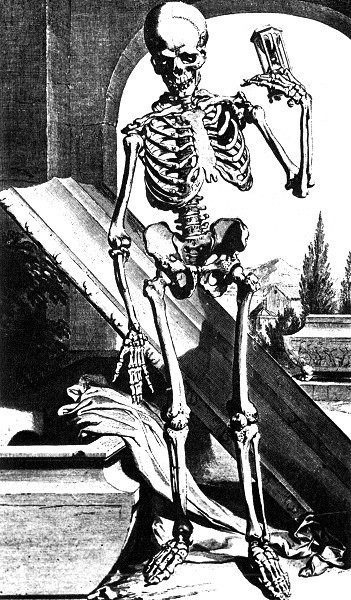
Artist: Gerard de Lairesse
From Anatomia Humani Corporus by Govard Bidloo (1685)
Perhaps the most gruesome symptom of dysentery is death itself. As Edward Cooke explained in his account of the privateering voyage with Woodes Rogers, once it started, it could take anyone in the crew down with it. Sea
surgeon John Moyle tells us that "[m]any dye miserably of it"1. Thomas Sydenham warns that if "the Fomes [material conveying an illness] of the Disease hav[e] not been first purged off ...this [is] generally is the Forerunner of imminent Death."2 Dutch military surgeon Raymund Minderer warns that "these Distempers [fluxes], especially the Bloody Flux, carry away abundance of Men."3
Several period surgeons put the blame for the death of men by bloody flux squarely at the feet of the surgeon. Thomas Aubrey explains that if a patient "be erroneously handled even towards the latter end, he may linger out two or three Months, and dye at last."4 The great physician Thomas Sydenham warns that "unless it is skillfully treated, it endangers the Patient's Life"5. Moyle gives the affair a more optimistic cast, noting that while "some are brought to deaths door by it, but through Providence and good looking after, do recover."6 We will look in detail at various ways the period surgeons attempted to cure the illness a bit later.
Several authors provide us with symptoms that they consider forerunners of death in a dysentery.
William Cockburn suggests that the surgeon will find "great Quantity of Blood (which is always, when any Part is inflamed) corrupts and turns black; which is a Mortification. And therefore it is evident, that a Mortification is in a Dysentery, when the Guts are inflamed, and the Sick die under these Circumstances of the Disease."7
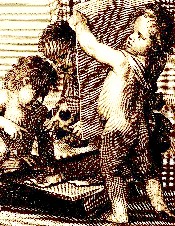
Gerard de Lairesse (1685)
John Woodall explains that "when convulsions of the
sinewes, hickett [hiccups], and vomiting, or any one of these signes, especially the two first appeare, then commonly death is at hand."8
Thomas Sydenham gives some of the most extraordinary comments on this front, explaining that when the patient's "Hands and Feet [are] growing cold, he will be in danger of dying; and if he should escape Death at this time... [when] pure Blood, unmix'd with Slime, is evacuated in a larger quantity [each] time... the Patient is in danger of Death; and sometimes also by reason of the great Burning, which is caused by a large Flux of hot and sharp Humours to the Parts affected, the Intestines are gangren'd."9
Even a pirate would probably be appalled at the thought of gangrened guts!
1 John Moyle, The Sea Chirurgeon, p. 169; 2 Thomas Sydenham, The Whole Works of that Excellent Practical Physician Dr. Thomas Sydenham, 10th Edition, p. 118; 3 Raymund Minderer, A Body of Military Medicines Experimented, Volume 4 of Paul Barbette's, Thesaurus Chirurgiæ, The Fourth Edition, p. 70; 4 Thomas Aubrey, The Sea-Surgeon or the Guinea Man’s Vadé Mecum., p. 76; 5 Sydenham, ibid.; 6 Moyle, ibid.; 7 William Cockburn, The Nature and Cure of Fluxes, p. 269; 8 John Woodall, the surgions mate, p. 215; 9 Sydenham, ibid.

